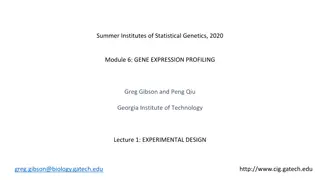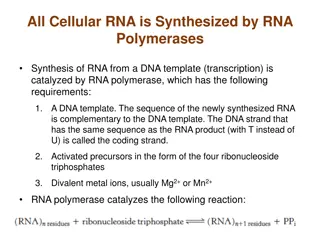Understanding Gene Translation: From RNA to Protein
Gene translation from RNA to protein involves the specific binding of transfer RNA molecules to messenger RNA codons, enabling the translation of nucleotide sequences into amino acids. Each amino acid is attached to a specific tRNA through activating enzymes, and the anticodon on tRNA pairs with the complementary codon on mRNA. This process, involving initiation, elongation, and termination steps, ensures accurate protein synthesis. Visit the provided links for detailed illustrations.
Download Presentation

Please find below an Image/Link to download the presentation.
The content on the website is provided AS IS for your information and personal use only. It may not be sold, licensed, or shared on other websites without obtaining consent from the author. Download presentation by click this link. If you encounter any issues during the download, it is possible that the publisher has removed the file from their server.
E N D
Presentation Transcript
Gene Translation:RNA -> Protein How does a particular sequence of nucleotides specify a particular sequence of amino acids? The answer: by means of transfer RNA molecules, each specific for one amino acid and for a particular triplet of nucleotides in messenger RNA (mRNA) called a codon. The family of tRNA molecules enables the codons in a mRNA molecule to be translated into the sequence of amino acids in the protein. At least one kind of tRNA is present for each of the 20 amino acids used in protein synthesis. (Some amino acids employ the services of two or three different tRNAs, so most cells contain as many as 32 different kinds of tRNA.) The amino acid is attached to the appropriate tRNA by an activating enzyme (one of 20 aminoacyl- tRNA synthetases) specific for that amino acid as well as for the tRNA assigned to it. Each kind of tRNA has a sequence of 3 unpaired nucleotides the anticodon which can bind, following the rules of base pairing, to the complementary triplet of nucleotides the codon in a messenger RNA (mRNA) molecule. Just as DNA replication and transcription involve base pairing of nucleotides running in opposite direction, so the reading of codons in mRNA (5' -> 3') requires that the anticodons bind in the opposite direction. Anticodon: 3' CGA 5' Codon: 5' GCU 3' The RNA Codons Second nucleotide U C A G U UUU Phenylalanine (Phe) UCU Serine (Ser) UAU Tyrosine (Tyr) UGU Cysteine (Cys) U UUC Phe UCC Ser UAC Tyr UGC Cys C UUA Leucine (Leu) UCA Ser UAA STOP UGA STOP A UUG Leu UCG Ser UAG STOP UGG Tryptophan (Trp) G C
CUU Leucine (Leu) CCU Proline (Pro) CAU Histidine (His) CGU Arginine (Arg) U CUC Leu CCC Pro CAC His CGC Arg C CUA Leu CCA Pro CAA Glutamine (Gln) CGA Arg A CUG Leu CCG Pro CAG Gln CGG Arg G A AUU Isoleucine (Ile) ACU Threonine (Thr) AAU Asparagine (Asn) AGU Serine (Ser) U AUC Ile ACC Thr AAC Asn AGC Ser C AUA Ile ACA Thr AAA Lysine (Lys) AGA Arginine (Arg)
A AUG Methionine(Met) or START ACG Thr AAG Lys AGG Arg G G GUU Valine Val GCU Alanine (Ala) GAU Aspartic acid (Asp) GGU Glycine(Gly) U GUC (Val) GCC Ala GAC Asp GGC Gly C GUA Val GCA Ala GAA Glutamic acid (Glu) GGA Gly A GUG Val GCG Ala GAG Glu GGG Gly G Note: Most of the amino acids are encoded by synonymous codons that differ in the third position of the codon. In some cases, a single tRNA can recognize two or more of these synonymous codons. Example: phenylalanine tRNA with the anticodon 3' AAG 5' recognizes not only UUC but also UUU. The violation of the usual rules of base pairing at the third nucleotide of a codon is called "wobble" The codon AUG serves two related functions It begins every message; that is, it signals the start of translation placing the amino acid methionine at the amino terminal of the polypeptide to be synthesized. When it occurs within a message, it guides the incorporation of methionine. Three codons, UAA, UAG, and UGA, act as signals to terminate translation. They are called STOPcodons. The Stepsof Translation
1. Initiation The small subunit of the ribosomebinds to a site "upstream" (on the 5' side) of the start of the message. It proceeds downstream (5' -> 3') until it encounters the start codonAUG. (The region between the mRNA cap and the AUG is known as the 5'-untranslated region [5'-UTR].) Here it is joined by the large subunit and a special initiator tRNA. The initiator tRNA binds to the P site (shown in pink) on the ribosome. In eukaryotes, initiator tRNA carries methionine (Met). (Bacteria use a modified methioninedesignated fMet.) 2. Elongation An aminoacyl-tRNA (a tRNA covalently bound to its amino acid) able to base pair with the next codonon the mRNA arrives at the A site (green) associated with: an elongation factor (called EF-Tu in bacteria; EF-1 in eukaryotes) GTP (the source of the needed energy) The preceding amino acid (Met at the start of translation) is covalently linked to the incoming amino acid with a peptide bond (shown in red). The initiator tRNA is released from the P site. The ribosome moves one codondownstream. This shifts the more recently-arrived tRNA, with its attached peptide, to the P site and opens the A site for the arrival of a new aminoacyl-tRNA. This last step is promoted by another protein elongation factor (called EF-G in bacteria; EF-2 in eukaryotes) and the energy of another molecule of GTP. Note: the initiator tRNA is the only member of the tRNA family that can bind directly to the P site. The P site is so-named because, with the exception of initiator tRNA, it binds only to a peptidyl-tRNAmolecule; that is, a tRNA with the growing peptide attached. The A site is so-named because it binds only to the incoming aminoacyl-tRNA; that is the tRNA bringing the next amino acid. So, for example, the tRNA that brings Met into the interior of the polypeptide can bind only to the A site. 3. Termination The end of translation occurs when the ribosome reaches one or more STOP codons(UAA, UAG, UGA). (The nucleotides from this point to the poly(A) tail make up the 3'-untranslated region [3'-UTR] of the mRNA.) There are no tRNA molecules with anticodonsfor STOP codons. However, protein release factors recognize these codonswhen they arrive at the A site. Binding of these proteins along with a molecule of GTP releases the polypeptide from the ribosome. The ribosome splits into its subunits, which can later be reassembled for another round of protein synthesis.























